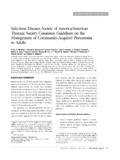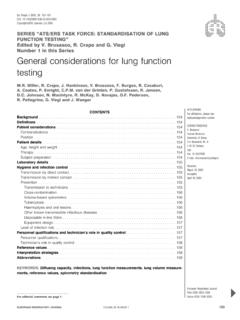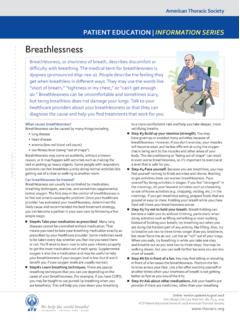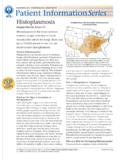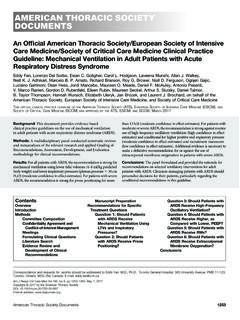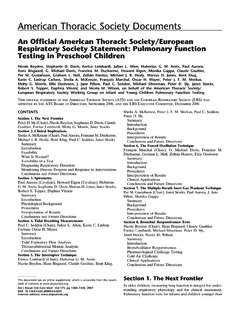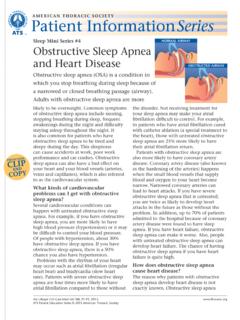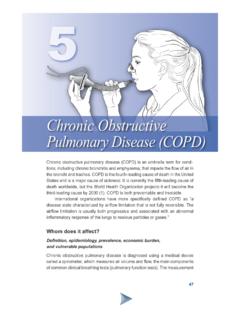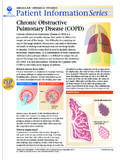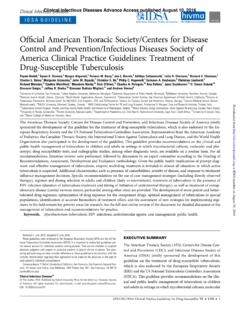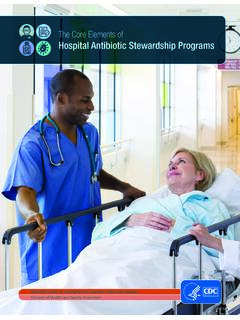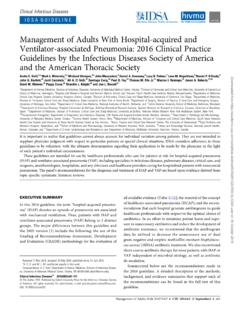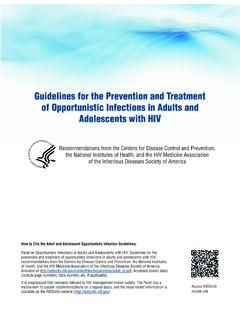Transcription of Infectious Diseases Society of America/American Thoracic ...
1 IDSA/ATS Guidelines for CAP in Adults CID 2007:44 (Suppl 2) S27 SUPPLEMENT ARTICLEI nfectious Diseases Society of america /AmericanThoracic Society Consensus Guidelines on theManagement of Community-Acquired Pneumoniain AdultsLionel A. Mandell,1,aRichard G. Wunderink,2,aAntonio Anzueto,3,4 John G. Bartlett,7G. Douglas Campbell,8 Nathan C. Dean,9,10 Scott F. Dowell,11 Thomas M. File, ,13 Daniel M. Musher,5,6 Michael S. Niederman,14,15 Antonio Torres,16and Cynthia G. Whitney111 McMaster University Medical School, Hamilton, Ontario, Canada;2 Northwestern University Feinberg School of Medicine, Chicago, Illinois;3 University of Texas Health Science Center and4 South Texas Veterans Health Care System, San Antonio, and5 Michael E.
2 DeBakey VeteransAffairs Medical Center and6 Baylor College of Medicine, Houston, Texas;7 Johns Hopkins University School of Medicine, Baltimore, Maryland;8 Division of Pulmonary, Critical Care, and Sleep Medicine, University of Mississippi School of Medicine, Jackson;9 Division of Pulmonary andCritical Care Medicine, LDS Hospital, and10 University of Utah, Salt Lake City, Utah;11 Centers for disease Control and Prevention, Atlanta,Georgia;12 Northeastern Ohio Universities College of Medicine, Rootstown, and13 Summa Health System, Akron, Ohio;14 State University of NewYork at Stony Brook, Stony Brook, and15 Department of Medicine, Winthrop University Hospital, Mineola, New York.
3 And16 Cap de Servei dePneumologia i Alle` rgia Respirato` ria, Institut Cl nic del To` rax, Hospital Cl nic de Barcelona, Facultat de Medicina, Universitat de Barcelona, Institutd Investigacions Biome` diques August Pi i Sunyer, CIBER CB06/06/0028, Barcelona, SUMMARYI mproving the care of adult patients with community-acquired pneumonia (CAP) has been the focus of manydifferent organizations, and several have developedguidelines for management of CAP. Two of the mostwidely referenced are those of the Infectious DiseasesSociety of america (IDSA) and the american ThoracicSociety (ATS).
4 In response to confusion regarding dif-ferences between their respective guidelines, the IDSAand the ATS convened a joint committee to develop aunified CAP guideline guidelines are intended primarily for use byemergency medicine physicians, hospitalists, and pri-mary care practitioners; however, the extensive litera-ture evaluation suggests that they are also an appro-Reprints or correspondence: Dr. Lionel A. Mandell, Div. of Infectious Diseases ,McMaster University/Henderson Hospital, 5th Fl., Wing 40, Rm. 503, 711 Concession St., Hamilton, Ontario L8V 1C3, Canada official statement of the Infectious Diseases Society of america (IDSA)and the american Thoracic Society (ATS) was approved by the IDSA Board ofDirectors on 5 November 2006 and the ATS Board of Directors on 29 Infectious Diseases2007; 44:S27 72 2007 by the Infectious Diseases Society of america .
5 All rights $ : starting point for consultation by overlap exists among the patients whomthese guidelines address and those discussed in the re-cently published guidelines for health care associatedpneumonia (HCAP). Pneumonia in nonambulatoryresidents of nursing homes and other long-term carefacilities epidemiologically mirrors hospital-acquiredpneumonia and should be treated according to theHCAP guidelines. However, certain other patientswhose conditions are included in the designation ofHCAP are better served by management in accordancewith CAP guidelines with concern for of Guideline Recommendations1.
6 Locally adapted guidelines should be imple-mented to improve process of care variables andrelevant clinical outcomes. (Strong recommen-dation; level I evidence.)It is important to realize that guidelines cannot always account for individualvariation among patients. They are not intended to supplant physician judgmentwith respect to particular patients or special clinical situations. The IDSA considersadherence to these guidelines to be voluntary, with the ultimate determinationregarding their application to be made by the physician in the light of each patient sindividual CID 2007:44 (Suppl 2) Mandell et for developing these guidelines derives, in largepart, from evidence that previous CAP guidelines have led toimprovement in clinically relevant outcomes.
7 Consistently ben-eficial effects in clinically relevant parameters (listed in table 3)followed the introduction of a comprehensive protocol (in-cluding a combination of components from table 2) that in-creased compliance with published guidelines. The first rec-ommendation, therefore, is that CAP management guidelinesbe locally adapted and CAP guidelines should address a comprehensive set ofelements in the process of care rather than a single elementin isolation. (Strong recommendation; level III evidence.)3. Development of local CAP guidelines should be directedtoward improvement in specific and clinically relevantoutcomes.
8 (Moderaterecommendation;levelIIIevidence .)Site-of-Care DecisionsAlmost all of the major decisions regarding management ofCAP, including diagnostic and treatment issues, revolvearound the initial assessment of severity. Site-of-care decisions( , hospital vs. outpatient, intensive care unit [ICU] ward) are important areas for improvement in admission Severity-of-illness scores, such as the CURB-65 criteria(confusion, uremia, respiratory rate, low blood pressure,age 65years or greater), or prognostic models, such asthe Pneumonia Severity Index (PSI), can be used to iden-tify patients with CAP who may be candidates for out-patient treatment.
9 (Strong recommendation; level Ievidence.)5. Objective criteria or scores should always be supple-mented with physician determination of subjective fac-tors, including the ability to safely and reliably take oralmedication and the availability of outpatient support re-sources. (Strong recommendation; level II evidence.)6. For patients with CURB-65 scores 2, more-intensivetreatment that is, hospitalization or, where appropriateand available, intensive in-home health care services isusually warranted. (Moderate recommendation; level IIIevidence.)Physicians often admit patients to the hospital who couldbe well managed as outpatients and who would generally preferto be treated as outpatients.
10 Objective scores, such as the CURB-65 score or the PSI, can assist in identifying patients who maybe appropriate for outpatient care, but the use of such scoresmust be tempered by the physician s determination of addi-tional critical factors, including the ability to safely and reliablytake oral medication and the availability of outpatient admission Direct admission to an ICU is required for patients withseptic shock requiring vasopressors or with acute respi-ratory failure requiring intubation and mechanical ven-tilation. (Strong recommendation; level II evidence.)8. Direct admission to an ICU or high-level monitoring unitis recommended for patients with 3 of the minor criteriafor severe CAP listed in table 4.
